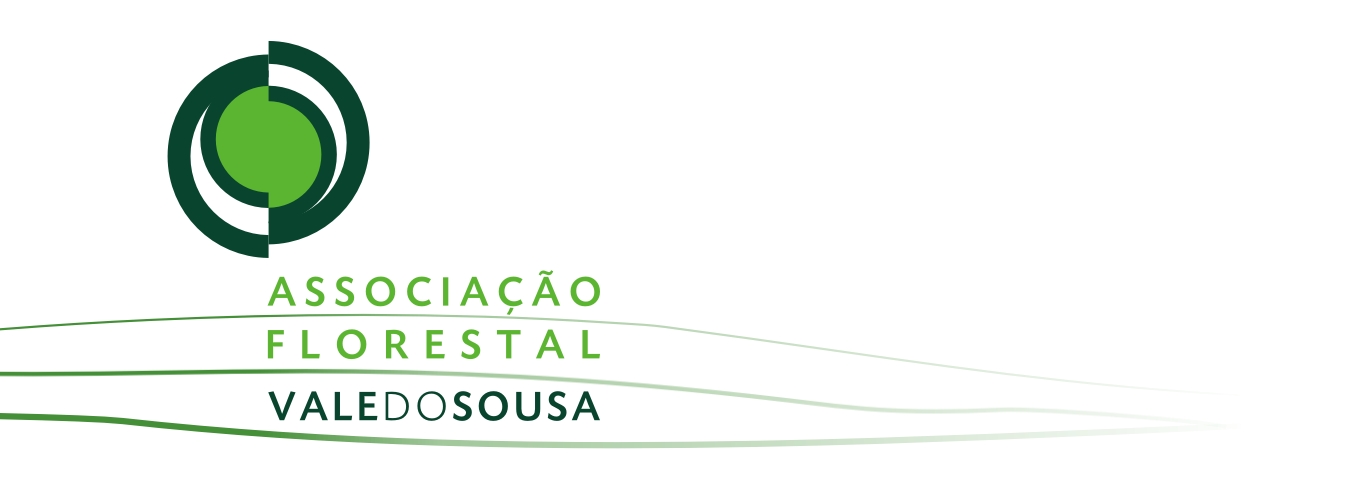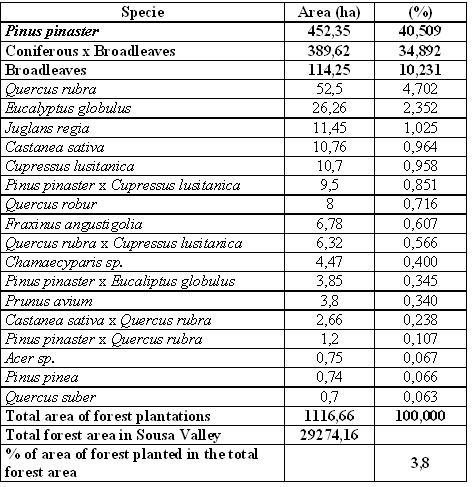Percentage of the total forest covered: 100 %
Costs
TOTAL COST: 27 €
The total cost includes :
1- Data analysis: 27 €
Results
Area of the main species planted between 1994 and 2004 in Sousa Valley co-financed by EU forest programmes
Source: AFVS
Area of eucalyptus belonging to the pulp and paper industries in Sousa Valley in 2005
Sources: 1- AFVS; 2- NFI, 2005
Remarks
This indicator is substituting the indicator C4.2 – Regeneration because
1) Data about regeneration was not available
The indicator C4.2 - Regeneration, defined as the area of regeneration according to the regeneration type, natural or artificial was not feasible at the pilot zone level. However, the field work carried out in FORSEE plots allow the field team to observe the following:
- In mixed and abandoned stands the natural regeneration was abundant and constituted by Quercus sp., Arbutus unedo and Pinus pinaster;
- Natural and artificial regeneration is very important to assure the continuity of the forest stands. In Sousa Valley, natural regeneration seems not to be sufficient to assure the sustainability of Pinus pinaster stands. One of the reasons is the forest fires that every year destroys it;
- The regeneration of Eucalyptus globulus stands is assured by plantation and also by natural regeneration. Also here the natural regeneration is threatened by the forest fires;
- Once having the forest burnt, more difficult it is to keep the forest owners motivated to prepare the soil and to plant the land again. The abandonment of the stands and the lack of management, sometimes due to the frequency of forest fires, make natural regeneration grow in excess. This happens mainly in Eucalyptus stands belonging to NIPFOs and can be negative for SFM because it reduces the diversity of plants and increase again the risk of forest fires, favouring its propagation and the degree of danger. The excessive regeneration can also turn the forest more susceptible to the attacks of pests and diseases.
- During the field work carried out under FORSEE project it was also observed the Pteridium aquilinium in the undercover. This can be negative for natural regeneration since it competes with it for sun light.
2) Plantations are very important in the pilot zone
Given the importance of plantations in Sousa Valley, North Portugal team decided to present the information about plantations in Sousa Valley as a new indicator. This indicator is important since the forest in the pilot zone is mainly forest of production that is continuously regenerated to produce raw material for the pulp and paper industries. The pulp and paper industries can plant new areas and regenerate by plantation areas formerly planted with eucalyptus.
In Sousa Valley, especially since 1994, the EU co-financed afforestation projects and the services provided by the local FOA have been given support for NIPFO to plant new forest areas or to plant previous forest areas with different species from the ones that were there.
2.1) Plantation by NIPFO
The table above shows the main species planted between 1994 and 2004 in Sousa Valley by NIPFOs. In order to take advantage of the EU co-financed forest programmes many forest owners have asked to the local FOA to draw the forest management plans and to provide them the technical assistance required for the implementation of new forest areas. These plantations may happen in agricultural land or in forest land were the previous specie was not the one they planted through forest programmes and it is not possible to find whether it is regeneration or not;
In terms of accumulated area, between 1994 and 2005 the NIPFO supported by EU afforestation programmes planted about 3,8% of forest in Sousa Valley.
2.2) Plantation by pulp and paper industries
In addition, in 2005 there were about 17099, 51 hectares of pure eucalyptus stands in Sousa Valley. In 2005, 4900 ha of eucalyptus were under the management of pulp and paper industries. This area could have resulted from new plantations, natural regeneration and regeneration by plantation. Pulp and paper industries must keep records of the area planted every year in Sousa Valley but FORSEE team did not try to find if these data were available or not upon request close to the pulp and paper industries. Considered that this area was all planted, this corresponds to a percentage of 16,7% of the total forest area in Sousa Valley.
Problems and improvements
In Sousa Valley, eucalyptus plantations are important not only in terms of the amount of forest land they represent, but also because they are the forest species that can generate income more quickly for forest owners.
In many cases they have been replacing pine forests and other kinds of forests destroyed by forest fires.
For these reasons these plantations need to be monitored very closely. Building capacity for forest inventory in the local forest owners’ association is a way to improve this kind of monitoring.
Conclusions



Initiative Communaitaire FEDER
INTERREG IIIB Espace Atlantique

